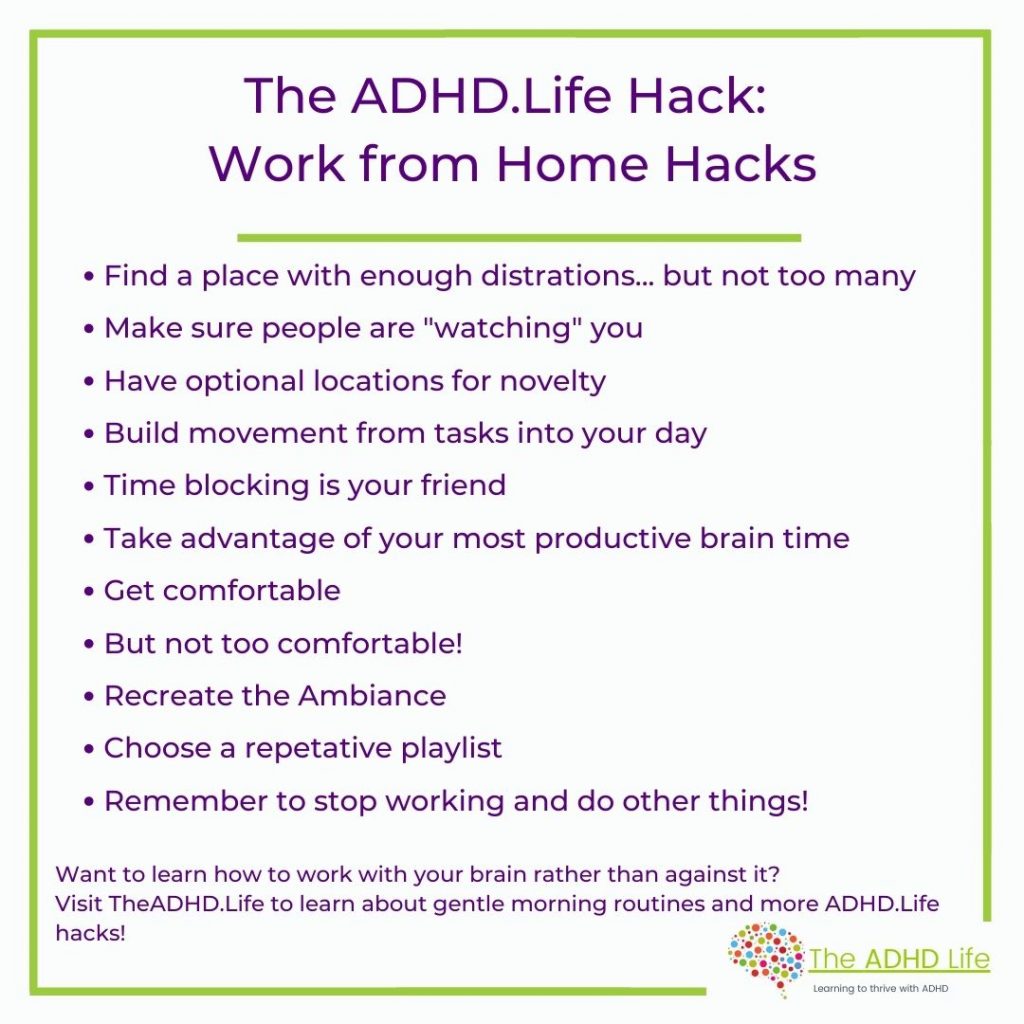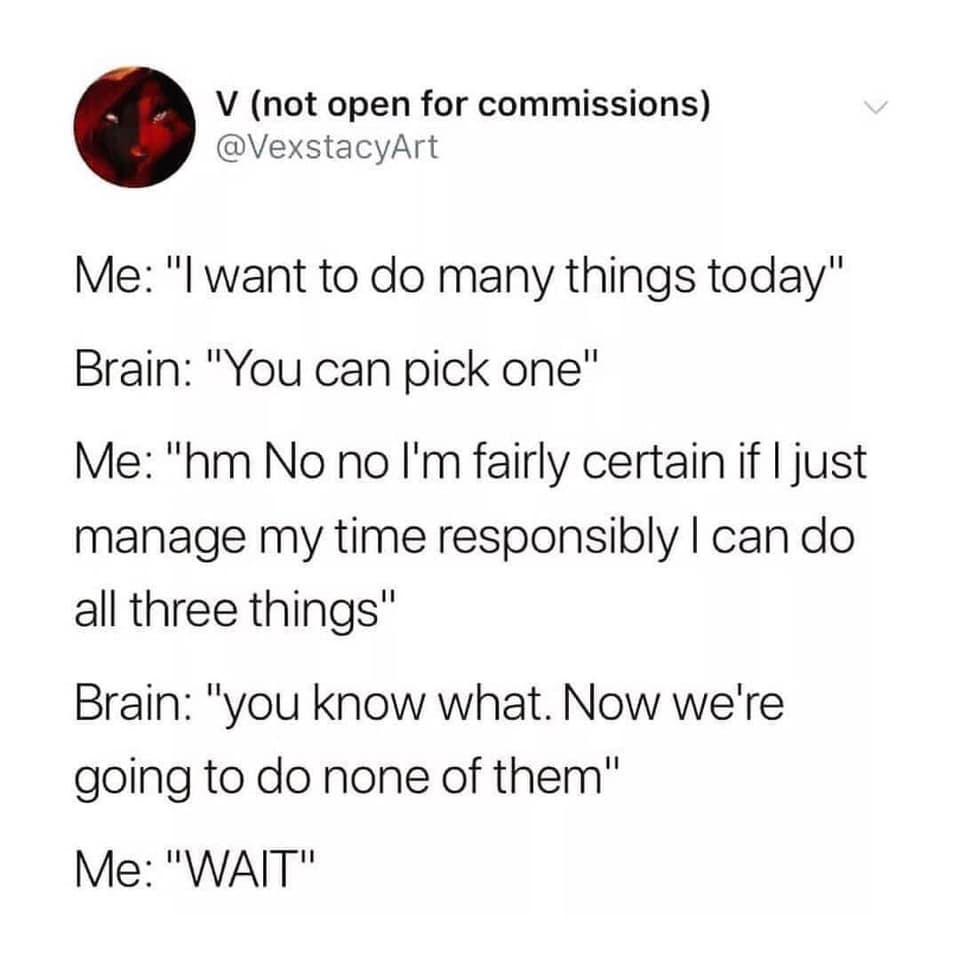In the “before-times” when I’d hit a rut in my home office I would change locations and head to a coffee shop for a change of scenery. This was incredibly effective for finding my groove1 for most writing projects. As a writer this groove is essential for my success. This has also been the hardest thing to figure out while working from home during Covid, because sitting in a coffee shop for hours is simply not safe or healthy.
Because the ADHD brain is primed for novelty and rejects any sort of boredom, these changes in scenery are how I keep my brain happy. For a while I was able to trick my brain by moving to the couch in the living room or the dining room table.
Then we moved to a new state and a new temporary environment, after taking several months off work to recover from major surgery. I’ve not been able to find my groove since.
I think it may be the result of too much change rather than not enough. We’re living with family temporarily and my temporary office was in the garage. I thought if I only had quiet space to focus I could things done. I was wrong. It has not been a successful location. I’m hoping it’s a location thing rather than a brain thing.2
So today, on a Monday morning3 I’m attempting a reset by moving my office area to the living room of a house shared with eight other people. My goal? Recreate a coffee shop experience in the living room hoping for added focus.
Why is it easier to focus in a coffee shop than at home or in your office?
It seems counterintuitive that it would be easier to focus with more distractions rather than with less, but it’s the reality of my life lately. But I’ve realized it’s a very ADHD thing in general
When your ADHD brain doesn’t have enough to focus on it’s easy for it to create distractions, or just get bored and shut down to nap. Most of the “work from home tips” for neurotypical humans aren’t effective for people with ADHD who are attempting to working from home.
Instead the ADHD “How to work from home” list looks something like this and recreates the best parts of the coffee shop experience from the before-times.

How to Work from home with ADHD
- Find a place with enough distractions… but not too many. The goal here is to make sure your brain has enough outside input that it needs to actively work to ignore distractions… making it easier to focus on the most important task of the day.
- Make sure people are “watching” you. It doesn’t even need to be people. I have a dog, Susan, who is the head of HR for my company. I am the human she needs to manage. We will go for walks and talk out more complicated projects or problems. She’s a great listener and her feedback is always “give me more treats and snuggles” but she’s a good sounding board for problems I’m facing. But I also imagine she’s watching me work and silently judging me when my productivity isn’t optimal.
I also have kids and adult humans in the space that are in and out and expect me to be contributing to the household by actively engaging in paid work throughout the day. Making sure I’m working when they’re walking by so they aren’t disappointed in me is helpful.4
- Have optional locations for novelty. I like to move from the desk to couch for a change of scenery, or I’ll move outside to the porch for a bit. Writing from my phone in the tub or the hammock also helps my creativity and productivity- as counter-intuitive as that is for most neurotypical humans.
- Build movement into your day. The process of packing up my computer and bag before heading to the coffee shop was more than a shift in location, but also a mental shift for a “fresh start.” The movement from the house to the car, the car to the coffee shop, then navigating traffic and interacting with the barista, all of this helped to shake loose the cobwebs and give my brain some activity to feed the need for change and get in some hits of dopamine. Then I could sit down at the coffee shop with a latte in hand and get right to work and find focus almost immediately, when it had been elusive previously.
To recreate that at home, I take the dog for a walk around the block, take 30 minutes to sit outside on the swing and read a book or take a shower. What my brain wants to do is seek dopamine by scrolling on my phone through social media or… nope, that’s it. That’s what my brain wants to do all the time. I try not to give into social media until I’ve gotten at least my one most important task for the day done. If I’ve not managed to do that and I’m feeling antsy moving my body is the best option to shake the urge.

- Time blocking. There is only a limited amount of time that’s acceptable to sit in a coffee shop. There isn’t an exact formula, but there is a general “vibe.” I can order one drink and feel cool to sit and write for several hours. It’s the perfect chunk of time to get into the flow for one major task. I know all the pomodoro method experts seem to think 25 minutes is long enough, but when I’m working on a writing project that needs to be closer to two or three hours. It’s a solid chunk of time investment for one project or client.
I recreate this at home by setting one client objective per day and trying to spend my first chunk of time focused solely on one project for that client for several hours. I pretend like the people watching me5 are that client specifically. It’s enough to keep me productive (usually) and focused. - Take advantage of your most productive brain time. ADHD brains aren’t usually great at the typical 9-5 grind. Sometimes the most productive time of day is between 8 p.m. and 2 a.m. If your profession allows, this is a great way to stay on top of your work and utilize productive time for your brain. For me, when I’m feeling behind on my work and need to really, really be productive, I head to the coffee shop at 8 p.m. This change of the “usual” scenery helps me think differently about a project. The people who frequent your local coffee shop in the evening vs. the morning will shake loose some different creative juices. There is also a different sense of urgency when it’s night time.
When working from home I recreate this by taking a break mid-day and then getting back to work after dinner and work later into the evening. For me, the difference is that my kids are hanging out rather than working on their own school work. Or they’re talking to friends and the dog is a little bit more wound up. I’ll light a candle or have hot chocolate to change the “mood” of the house and will turn the lights off and only have a lamp on the table on, creating an ambiance that is vastly different than during the day. - Get comfortable. It helps to have the right temperature level or the right amount of hoodie to A/C ratio. Coffee shops are notoriously chilly. I can’t focus on anything else if my temperature isn’t correct. I like to keep my house chilly enough to wear a hoodie while I work. Especially when writing. There is something to the “vibe” of wearing a hoodie or a sweater when writing. I also do better with a mug of something warm, but not food. Food is a distraction. Feed yourself before attempting to get into the groove- or don’t…
- But not too comfortable! Discomfort can be your friend. I do intermittent fasting and don’t eat until I’ve gotten my first block of hours done for the day. There is something that the hunger does to my brain to make it function better and think more clearly. Same when my chair is too comfortable. I switch to an exercise ball or a stool without a back to give my brain something to concentrate on (keeping me upright) rather than sinking into a comfy chair.
- Recreate the ambiance. What does it smell like? What are the sounds? The smell of a coffee shop is connected in my brain to productivity. The combo of coffee, baked goods and whatever other productivity smells they pipe in does something to my brain. At home just brewing coffee helps shift my brain into gear. Sometimes it helps to switch the smells up though, it’s the whole, “give my brain something else to also focus on” trick. I’ll light a candle that’s a new smell and then it occupies part of my brain enjoying it while also focusing on other things.
- Choose a repetitive playlist. Headphoning to ignore everyone around me doesn’t help if I’m focusing more on the music in the headphones than I am on the work I’m doing. I read or heard somewhere that Michael Lewis, author of Moneyball, but also The Undoing Project, which is my favorite book of his, said he creates a playlist for each book he’s working on. Then when the playlist plays it automatically puts his brain into gear to work on that project. I took this advice to heart and created a playlist for a book I’m writing. It’s been so effective that I will use that playlist for other writing i’m working on as well, because it puts my brain in “writer mode.” But I also find focus in EDM or other music with repetitive beats and few if any words.
Bonus tip: Remember to do something other than work. My brain functions better when it has lots of things to choose from. This is a basic writing tip, but I think looking outside your bubble and exploring new ideas, places and stories is helpful for people with ADHD in general. One of the things our brains are primed for is taking seemingly unrelated ideas, stories or concepts and finding the connections between them. If there aren’t enough free ideas running around in my brain it’s hard to have any ideas at all to harness and talk or write about.
At a coffee shop I like to people watch. This can be a detriment to working, but if I show up and still can’t seem to get any work done then I’ll brainstorm backstories for the characters in the coffee shop around me. What are they doing? Why are they here? Are they clandestine lovers meeting up on the opposite side of town to have coffee together? Spies who are trading information? What about the barasta? What’s her story? She works at Starbucks as an undercover agent? It helps my brain to write the stories down just to clear out cobwebs and usually get down to business quite quickly.
The alternative to this is reading other people’s writing, go for walks in your neighborhood that aren’t the same as your typical route. Drive your car to a crowded area and people watch.
Covid may have made actually working in a coffee shop a bad idea, but the advantages of coffee shop work can still be harnessed, it just takes a little more foresight and effort. For me at least, it seems to be working… at least for today.
How do you handle working from home with ADHD? Tips? Tricks? Recommendations? Join the conversation on Facebook and share your ADHD life hacks and connect with other adults who are trying to hack their ADHD!
- otherwise known as hyper-focus [↩]
- I know, I heard myself as I wrote this- it’s always a brain thing with ADHD. [↩]
- at least when this article is being drafted [↩]
- They have never mentioned or said anything about my productivity levels, but the imaginary judgement in my head is helpful for my motivation. [↩]
- see tip two [↩]


